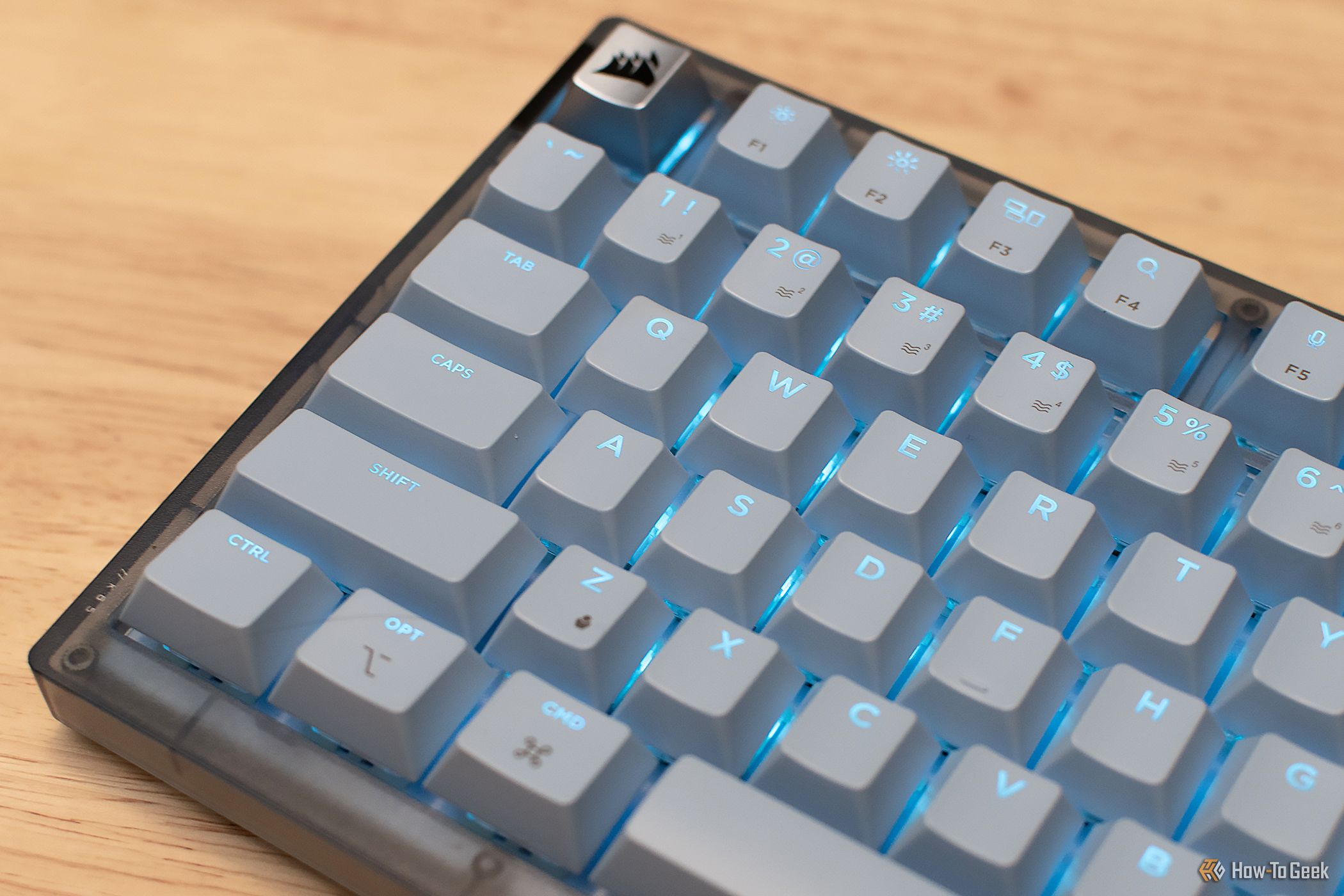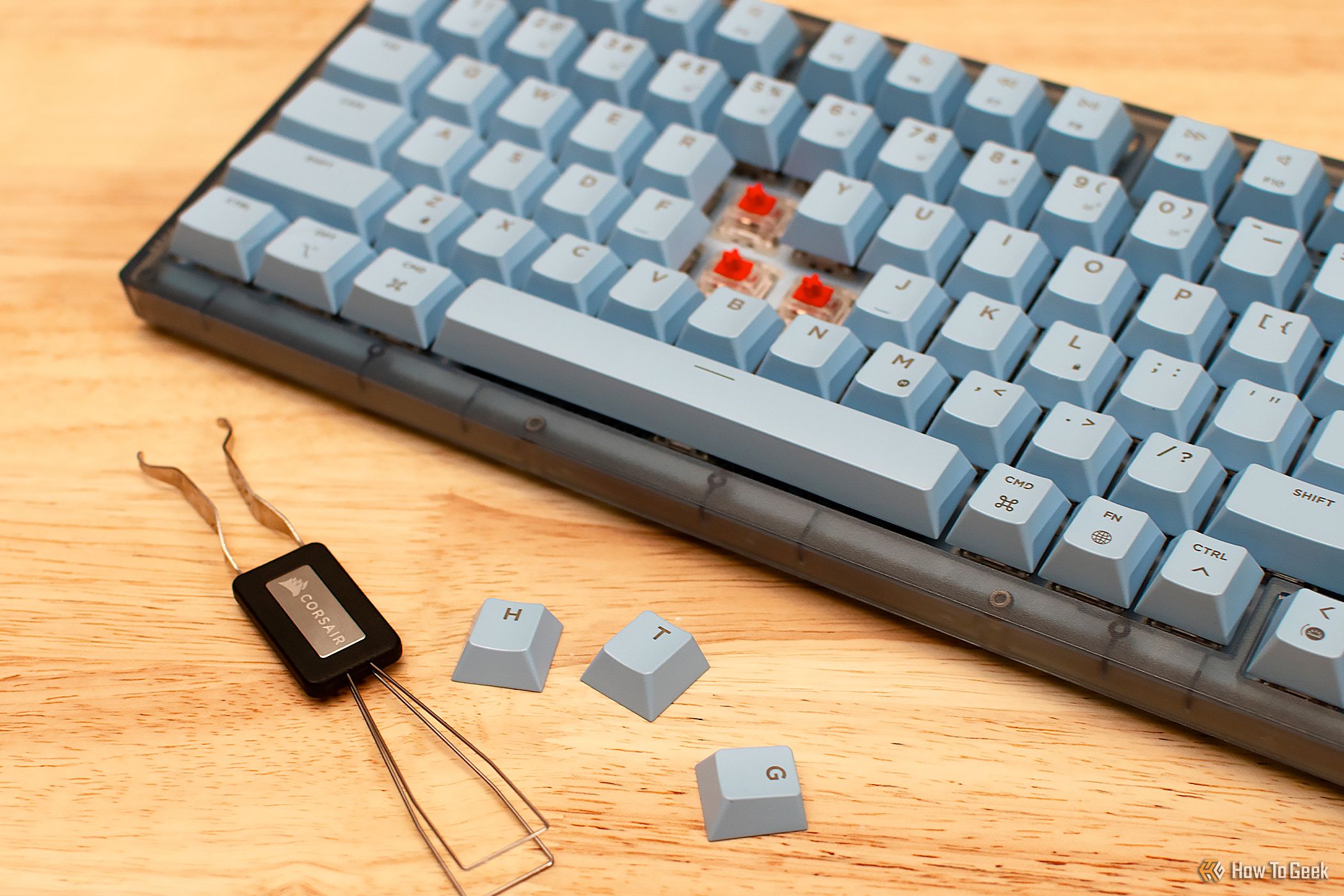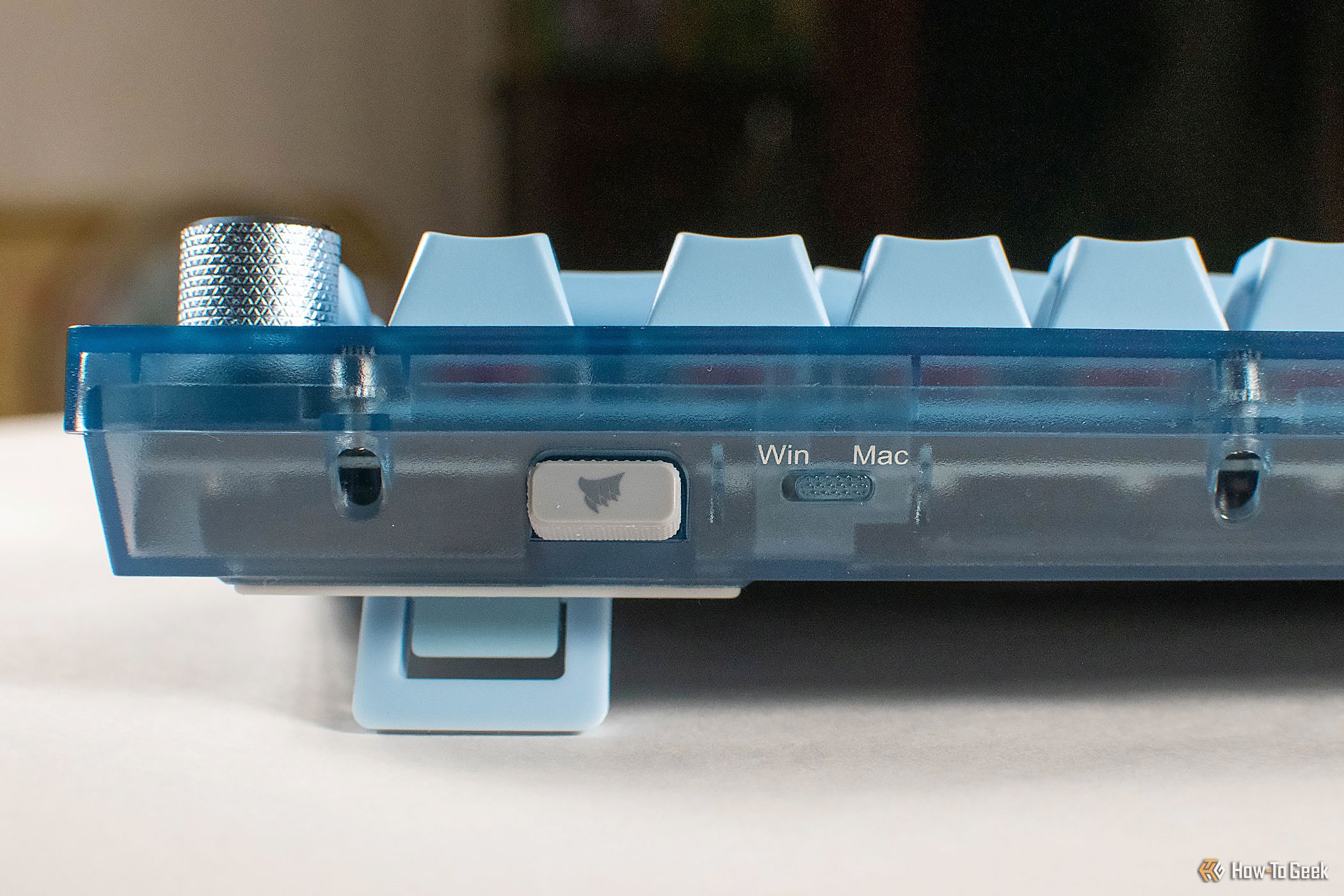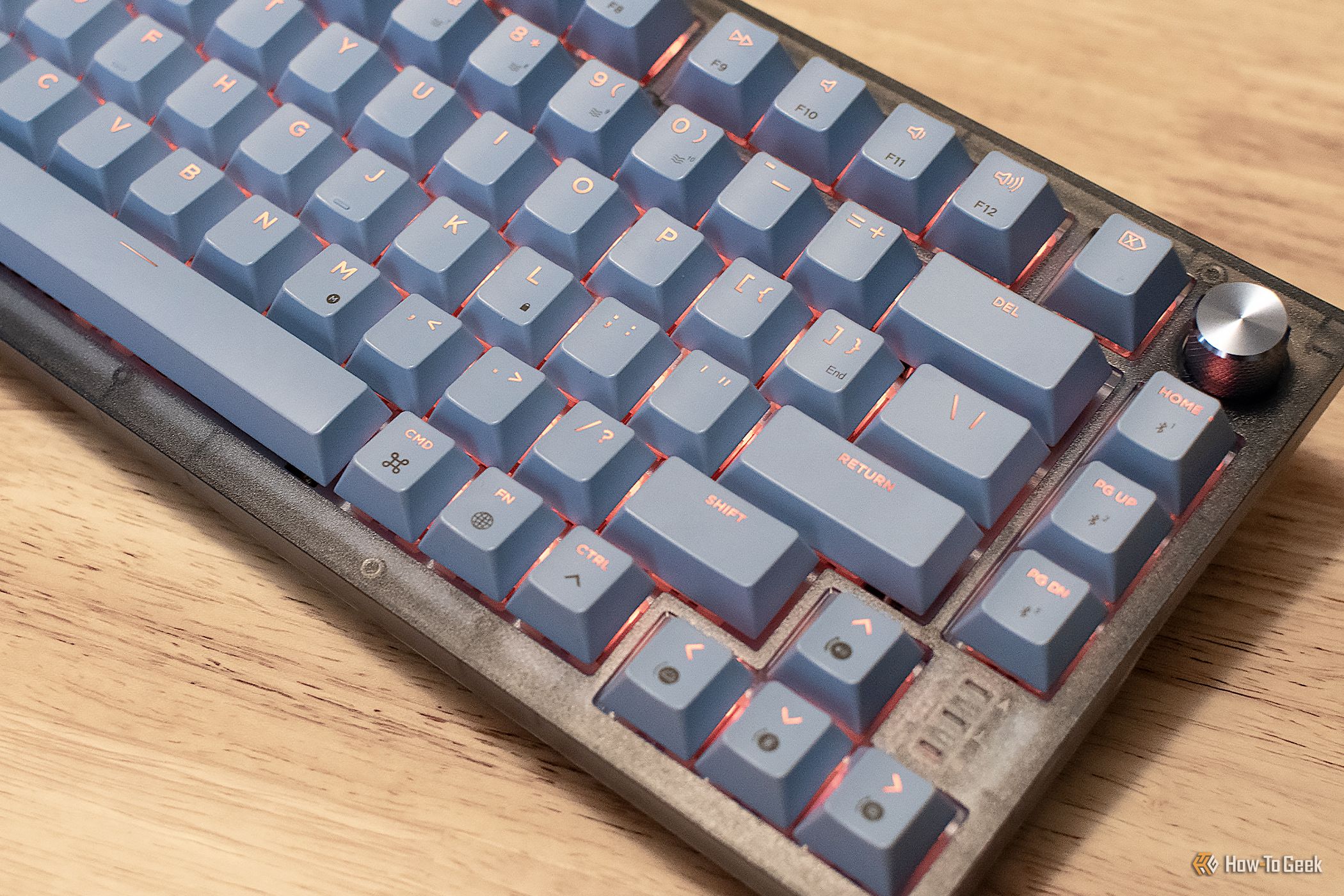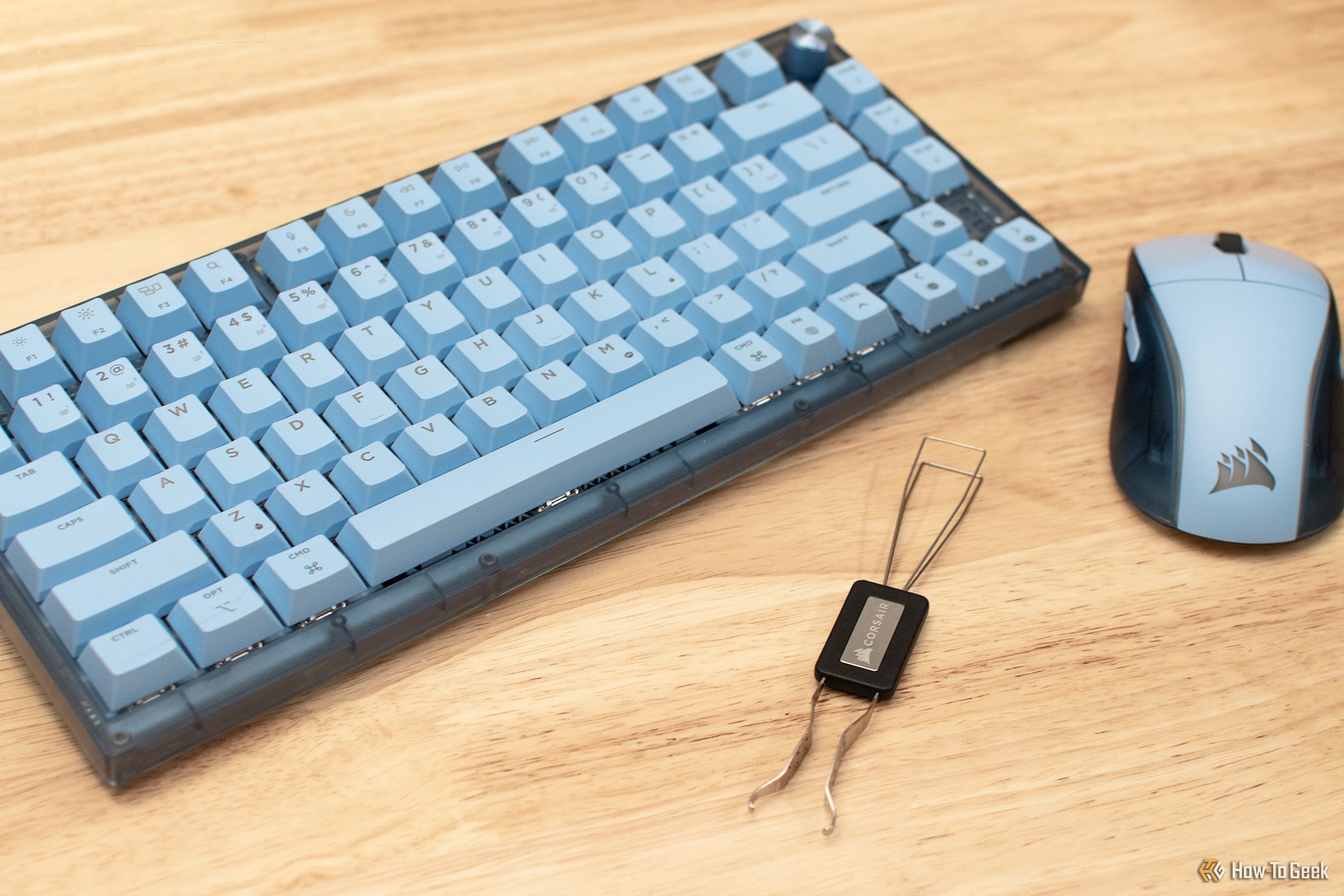One of Corsair’s most popular mechanical keyboards now has an Apple-exclusive paintjob. I had a lot of fun with the Glacier Blue K65 Plus, but I’m frustrated by its software limitations and its inflated price tag.
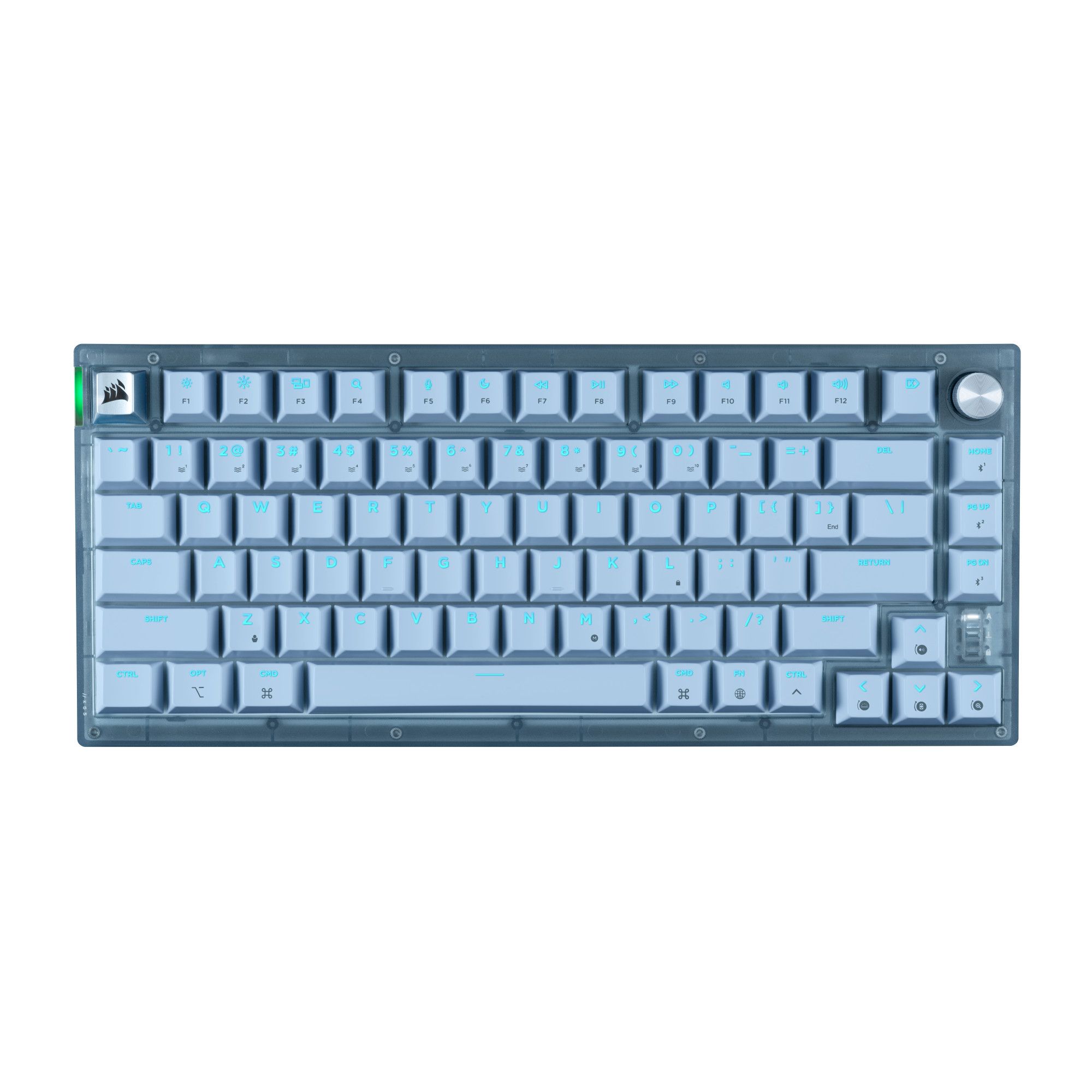

Corsair K65 Plus
$120 $160 Save $40
The Corsair K65 Plus mechanical gaming keyboard features pre-lubed, hot-swappable MLX Red linear switches and two layers of sound-dampening foam. It provides a soft, silky key response and connects over USB-C cable, 2.4GHz dongle, or Bluetooth.
- Pre-lubed linear switches provide a soft feel when gaming
- Great build quality despite the all-plastic chassis
- Unique color options
- USB, 2.4GHz wireless, and Bluetooth connectivity
- Apple-exclusive colorways are overpriced
- Custom RGB lighting doesn’t work in Bluetooth or 2.4GHz mode
- Corsair didn’t tweak its lighting presets for the Arctic Blue colorway
- 1,000Hz polling rate isn’t great at this price
Price and Availability
Corsair’s K65 Plus keyboard is available at most major retailers with prices starting at $160. However, the Glacier Blue colorway that’s featured in this review costs $180 and is sold exclusively at the Apple Store.
The K65 Plus comes with a keycap and switch remover, a 2.4GHz wireless USB dongle, and a USB-C to USB-C cable (you can use a USB-A to USB-C cable if that’s what you prefer).
Designed and Built Like a G3
At a functional level, the Apple-exclusive K65 Plus is identical to Corsair’s standard K65 Plus. They offer the same specs and features, including Windows and macOS connectivity. This Apple revision simply has a unique color scheme and Mac-specific keycaps.
Still, the exclusive Glacier Blue colorway is gorgeous. The keycaps have a unique powder-blue shade, while the chassis is a translucent arctic color. It actually reminds me of the iMac G3, which feels appropriate for an Apple tie-in. If I had some money and time to burn, I’d hunt down an iMac G3 for a little photoshoot—wouldn’t that be cute?
Yes, this color clashes with absolutely everything on my desk. It will probably clash with your stuff, too. But in a world of boring black and gray tech peripherals, I’m just happy to see something that pops. This is a good time to mention that the Apple Store sells a Frost White version, for those who want something more modest.
In terms of build quality, the K65 Plus is top-notch. Don’t let the plastic chassis deceive you—this thing is heavy. It also sports hot-swappable, pre-lubricated linear red switches, an impressive noise-dampening system (it’s extremely quiet for a mechanical keyboard), high-quality ABS keycaps with shine-through legends, and bright RGB backlighting.
A Very Soft Typing Experience
I’m a full-time writer and editor. So, I spend a lot of time typing. And while some people might enjoy typing on the K65 Plus, I found that the “silky smooth” design just makes me a sloppier typist.
The K65 Plus features hot-swappable components—you can use whatever switches and keycaps you want. But Corsair sells the keyboard with its own high-quality, pre-lubed MLX Red linear switches and smooth, shine-through ABS keycaps (the original black colorway does not have shine-through keycaps).
There are two layers of sound-dampening foam inside the keyboard’s chassis. The foam minimizes typing noise, of course, but it also adds a pillowy, soft feeling to each key press.
I make a lot of mistakes when typing on the K65 Plus. Its non-clicky linear switches just don’t provide enough tactile or auditory feedback. And although the switches have a fair amount of travel (4.0mm), they actuate at just 1.9mm. If you can type on the K65 Plus without fat-fingering the wrong keys, I salute you.
However, my complaints about sloppiness melt away when I fire up a game like Counter-Strike. There’s something about the soft, shallow response of the K65 Plus that makes WASD keys feel more responsive and fluid. The dampened linear switches also proved to be more comfortable than tactile switches, at least when performing repetitive key presses or holding a single key in place.
I don’t plan on using a linear keyboard for day-to-day typing, but the K65 Plus has convinced me to keep one on hand for gaming. I hope I’m not being spoiled by the pre-lubed switches and dual-layer dampening foam because I’m not sure that I’d like to spend this much money on a keyboard.
Anyways, as someone who tends to use a low-profile keyboard, the K65 Plus feels very tall. It measures just under 1.5 inches, and that’s before you flip out the legs, which provide an extra half inch of slope at their tallest setting (yes, the feet have two height settings). A tall keyboard is honestly a good thing. It forces you to “hover” your wrists in the air, which reduces your risk of carpal tunnel and other repetitive stress injuries.
The downside is that, if you’re unwilling to keep your wrists in the air, you’ll need a relatively thick wrist rest to comfortably type.
As for the keyboard’s layout—it’s fine, but I wish that Corsair had copied the layout from Apple’s Magic Keyboard. I’d really prefer to have the Function key on the left side of the Spacebar, rather than the right. I realize that this would force the Spacebar off-center, but I’d honestly prefer that, as it would make it easier to reach the Command key with my left thumb.
Solid Specs, With Some Exceptions
We’ve already covered the K65 Plus’ most important hardware specs—the switches, the travel distance, and so on. Still, the devil’s in the details, so it’s time to talk about some of the invisible stuff that can make or break a keyboard.
The Apple-exclusive K65 Plus costs $180, but its polling rate is locked at 1000Hz (even in wired mode). A fast 8000Hz polling rate won’t make you a better gamer, and most people can’t tell the difference, but a lot of enthusiasts (and non-enthusiasts who spend too much time on Reddit) refuse to buy a keyboard that isn’t super-duper-extra responsive.
Corsair markets the K65 Plus as a wireless keyboard, which is probably why it went with 1000Hz in wired mode. Admittedly, the wireless options here are pretty compelling. A low-latency 2.4GHz USB dongle is included in the box (the keyboard has a storage slot for this dongle, too), and you can swap between three Bluetooth connections by holding the Function key while pressing Home, Page Up, or Page Down.
The K65 Plus also features a dense 4,200mAh battery. It’s rated for 266 hours when connected over 2.4GHz wireless or Bluetooth, provided that you leave the RGB backlight disabled. So, even if you use the keyboard for eight hours a day, it should last well over a month on a single charge.
I tested the keyboard with RGB turned on. And, predictably, the backlight chews through battery. I had to charge the K65 about once every 10 days when using it for work. Yes, I probably could’ve eked out some extra battery life by reducing the backlight brightness (or by occasionally turning the backlight off—there’s a convenient button for this), but I chose to torture myself by leaving the backlight at maximum power.
I should clarify that the K65 Plus doesn’t have any cutting-edge software features like adjustable actuation or “Snap Tap.” It’s a meat and potatoes keyboard. The only exception is the macros system, which we’ll talk about in a minute.
Ugly RGB and Weird iCue Nonsense
Like any fancy-pants gaming keyboard, the K65 Plus has a bright RGB backlight with per-key lighting, rich animations, and a bunch of options for user customization. There are ten animated lighting presets burned into the keyboard’s onboard storage, though you can select additional lighting schemes or create your own lighting profile in the iCue app on your Mac or PC.
Full disclosure—I don’t care about RGB backlighting. A modest light that helps me read the keyboard is all I really need. But the RGB situation here is just stupid.
Corsair didn’t take the time to create lighting presets that complement this keyboard’s powder-blue paintjob. The built-in RBG options, accessed through the Function key, are straight-up fugly. Like, tons of primary colors, greens, and reds that totally clash with the blue chassis, awful. These lighting presets probably look good in a black or white chassis, but they should’ve been tweaked for the exclusive blue colorway that I’m reviewing today.
You might say, “calm down, Andrew, just set up a custom lighting profile in iCue.” But custom lighting only works in wired mode. There’s no way to save custom lighting profiles to the keyboard’s onboard storage. So, if you prefer Bluetooth or 2.4GHz wireless, you’re stuck with Corsair’s gaudy presets. A $180 wireless keyboard that loses one of its core features in wireless mode—ridiculous.
This problem extends to iCue’s custom key mapping feature, which only works over a wired or 2.4GHz connection. You can’t save custom key bindings to the K65, and you can’t use these bindings in Bluetooth mode. I prefer to remap my keys at the OS level, so it doesn’t affect me, but it’s a wonky design choice.
Thankfully, custom macros can be saved to the keyboard’s onboard storage. Hold the Function and M keys, type out a macro, assign it to a key combination (or a single key), and you’re good to go. No need to open iCue or fuss around with different connectivity methods; macros just work. You can even program macros while using the keyboard with a game console or phone.
These confusing limitations are kinda-sorta mentioned in the user manual, but they aren’t explained in any super-explicit way. And I’ve read at least two product reviews from people who incorrectly assumed (perhaps justifiably) that the K65 Plus can save custom lighting profiles to onboard storage.
I should reiterate that the K65 Plus is marketed as a wireless keyboard. You and I may prefer a wired connection (I certainly do), but I know for a fact that some customers will buy the K65 Plus, install iCue, and throw a fit when they realize that customization is nerfed in wireless mode. It’s a bizarre and silly limitation, especially at $180.
Should You Buy the Apple-Exclusive K65 Plus Keyboard?
Corsair’s Apple-exclusive K65 Plus is an excellent gaming keyboard, at least in terms of hardware quality and basic performance. There are plenty of things to complain about, including the bizarre RGB situation and the Apple-inflated price tag, but Corsair nailed the most important stuff. I’ll keep using my tactile keyboard at work, but I want to keep the K65 Plus on hand for gaming.
Still, I’d like to make one last complaint. The only thing that’s “Apple-exclusive” about this product is the fact that it’s trapped at the Apple Store and sold at a markup. Otherwise, it’s just a nice mechanical gaming keyboard with a unique paint job and some macOS-specific keycaps.
If Apple insists on selling an exclusive gaming keyboard, I’d really prefer an all-new model with a MacBook-inspired layout, sort of like the Vissles LP85 that I reviewed a few years ago. There are also models like the NuPhy Air75 V2 which are designed to fit over the top of a MacBook keyboard, which is a neat trick.
The Glacier Blue and Frost White versions of Corsair’s K65 Plus are sold exclusively at the Apple Store for $180. I suggest that you look into the standard black colorway first, as it regularly goes on sale for $145 at Amazon and is functionally identical to the Apple-exclusive model that I tested for this review.


Corsair K65 Plus
$120 $160 Save $40
The Corsair K65 Plus mechanical gaming keyboard features pre-lubed, hot-swappable MLX Red linear switches and two layers of sound-dampening foam. It provides a soft, silky key response and connects over USB-C cable, 2.4GHz dongle, or Bluetooth.


